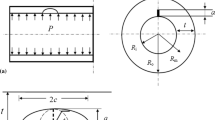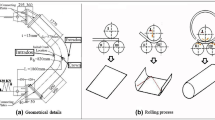Abstract
Crack growth simulation methods for estimating the failure probability of pipes in nuclear power plants were reviewed. A number of simulation programs have been developed by some authors and used effectively to estimate the failure probability of pipes. From the simulation results, it was found that the failure probability results were sensitive to several important input variables, including crack depth distribution, crack density, and performance level of inspections. Accurate input data should be provided to obtain confident results. The crack growth simulation is a convenient method to examine the effects of changes in design and operation variables. However, using this method as a regulatory tool has some challenges because the simulation results are too sensitive to the input variables. The input variables and equations must be defined carefully in relevant codes and regulations to use the crack growth simulation method as a regulatory tool. A fictitious crack size distribution may be used, which shows similar crack size distribution during plant operation.
Graphical abstract









Similar content being viewed by others
Data availability
Data are not available.
References
J.H. Park, C.H. Shin, J. Korean Soc. Saf. 32, 1–8 (2017)
D.O. Harris, E.Y. Lim, D.D. Dedhia, Probability of pipe fracture in the primary coolant loop of a PWR Plant, NUREG/CR-2189, vol. 5 (Science Applications Inc., Livermore, California, USA, 1981)
M.A. Khaleel, F.A. Simonen, Evaluation of Structural Failure Probabilities and Candidate In-service Inspection Programs, NUREG/CR-6986, Pacific Northwest National Lab., Washington, USA (2009)
H.M. Thomas, Reliab. Eng. 2, 83–124 (1981)
B. Lydell, Reliab.Eng. Syst. Saf. 68, 207–217 (2000)
B. Lydell, J. Rizinec, Nuclear Eng. Des. 238, 2115–2123 (2008)
B. Lydell, D.E. Forano, J. Riznic, Nucl. Eng. Des. 380, 111380 (2021). https://doi.org/10.1016/j.nucengdes.2021.111280
Reactor Safety Study: An Assessment of Accident Risks in US Commercial Nuclear Power Plants, USNRC Report, WASH-1400, NUREG-75/014 (1975)
R.E. Wright, J.A. Steverson, W.F. Zuroff, Pipe Break Frequency Estimation for Nuclear Power Plants, USNRC Report, NUREG/CR-4407 (1987)
R. Tregoning, L. Abramson, P. Scott, Estimating Loss-of-Coolant Accident (LOCA) Frequencies through the Elicitation Process, USNRC Report, NUREG-1829 (2008)
K. Jamali, Pipe Failures in U.S. Commercial Nuclear Power Plants, EPRI Report, EPRI TR-100380 (1992)
K.N. Fleming, T.J. Mikschl, et al., Pi** System Failure Rates and Rupture Frequencies for Using Risk Informed In-service Inspection Applications, EPRI Report, EPRI TR-111880-NP, Palo Alto, CA, USA (2000)
R. Nyman, et al., Reliability of Pi** System Components. Framework for Estimating Failure Parameters from Service Data, SKI Report 97:26, Swedish Nuclear Power Inspectorate, Stockholm, Sweden (1997)
S.H. Bush, et al., Pi** Failures in United States Nuclear Power Plants: 1961–1995, SKI Report 96:20, Swedish Nuclear Power Inspectorate, Stockholm, Sweden (1996)
American Petroleum Institute, Risk-Based Inspection Technology, API RP-581, 2nd Ed., American Petroleum Institute, Washington, USA (2008)
D.M. Norris, A. Okamoto, B. Chexal, T. Griesbach, PICEP: Pipe Crack Evaluation Program, EPRI Report, EPRI NP-3596-SR (1984)
D.O. Harris, D.D. Dedhia, S.C. Lu, Theoretical and User's Manual for pc-PRAISE, NUREG/CR-5864 (1992)
D.O. Harris, D.D. Dedhia, WinPRAISE 98: PRAISE Code in Windows, EMT TR-98–4–1 (1998)
D.O. Harris, D.D. Dedhia, WinPRAISE 07: Expanded PRAISE Code in Windows, Structural Integrity Associates, Inc. (2007)
PRO-LOCA-GUI/PRO-LOCA User's guide (Version 3.5.32), Battelle (2009)
J.H. Park, Development of a Program for Assessment of LOCA Probability of Pipes, KINS Report, KINS/HR-1337 (2014)
S.R. Gosselin, F.A. Simonen, S.P. Pilli, B. Lydell, Probabilities of Failure and Uncertainty Estimate Information for Passive Components – A Literature Review, NUREG/CR-6936 (2007)
J.H. Park, J.B. Lee, Y.H. Choi, "Effects of Several Factors on the Solution of Failure Probability of Pipes in Nuclear Power Plants," Proceedings of the ASME 2010 Pressure Vessels and Pi** Division, Bellevue, Washington, USA, PVP2010–25240 (2010)
J. Keisler, O.K. Chopra, W.J. Shack, Fatigue Strain-Life Behavior of Carbon and Low-Alloy Steels, Austenitic Stainless Steels and Alloy 600 in LWR Environments, NUREG/CR-6335, ANL-95/15 (1995)
I.S. Raju, J.C. Newman, J. Press. Vessel Tech. 104, 293–298 (1972)
API 579–1/ASME FFS-1, Fitness-For-Service, API, ASME (2007)
Y. Murakami, Stress Intensity Factors Handbook (Pergamon Press, Oxford, 1987)
Guide for Leak before Break Analysis and Defect Assessment, RCC-MR Section 1 - Subsection Z, Appendix A16 (2007)
A. Zahoor, Ductile fracture handbook (EPRI, 1989)
A.R. Maligno, S. Rajaratnam, S.B. Leen, E.J. Williams, Eng. Fract. Mech. 77, 94–111 (2010)
R. Branco, F.V. Antunes, J.D. Costa, Eng. Frac. Mech. 141, 170–195 (2015)
N. Moes, J. Dolbow, T. Belytschko, Internat. J. Numer. Methods Engrg. 46, 131–150 (1999)
K. Agathos, E. Chatzi, S.P.A. Bordas, Comput. Methods Appl. Mech. Eng. 306, 19–46 (2016)
X. Peng, E. Atroshchenko, P. Kerfriden, S.P.A. Bordas, Comput. Methods Appl. Mech. Engrg. 316, 151–185 (2017)
S. Li, M.E. Mear, L. **ao, Compt. Methods Appl. Mech. Engrg. 151, 435–459 (1998)
A. Frangi, Int. J. Frac. 116, 313–330 (2002)
G.P. Nikishkov, J.H. Park, S.N. Atluri, Comput. Model. Eng. Sci. 2, 401–422 (2001)
J.H. Park, G.P. Nikishkov, J. Mech. Sci. Tech. 25, 2335–2344 (2011)
L. Dong, S.N. Atluri, Comput. Model.Eng. Sci. 89, 417–458 (2012)
B.J. Carter, P.A. Wawrzynek, A.R. Ingraffea, Automated 3-D crack growth simulation. Internat. J. Numer. Methods Engrg. 47, 229–253 (2000)
A.M. Al-Mukhtar, S. Henkel, H. Biermann, P. Hübner, Jordan J. Mech. Indus. Eng. 3, 236–245 (2009)
A.M. Al-Mukhtar, H. Biermann, P. Hübner, S. Henkel, J. Mat. Eng. Perform. 19, 1225–1234 (2010)
E. Iesulauro, FRANC2D/L: A Crack Propagation Simulator for Plane Layered Structures, V. 1.5 User's Guide.
W. Marshall, An Assessment of the Integrity of PWR Pressure Vessels- A U.K. Study Group Report, G6/1, SMiRT 4, San Francisco, USA (1977)
W. Zhao, A. Stacey, "Review of Defect Distributions for Probabilistic Structural Integrity Assessment," Proceedings of OMAE02, 21st International Conference on Offshore Mechanics and Arctic Engineering, Oslo, Norway, OMAE2002–28616 (2002)
N. Recho, "Potential Use of Fracture Mechanics in the Fatigue Design of Fillet Welded Joints," Proc. 5th European Conf. on Fracture, Lisbon, Vol. 1 (1984)
P. Amirafshari, N. Barltrop, M. Wright, A. Kolios, Inter. J. Fatigue 145, 106069 (2021). https://doi.org/10.1016/j.ijfatigue.2020.106069
M. Khaleel, V. Chapman, D.O. Harris, F. Simonen, Flaw size distribution and flaw existence frequencies in nuclear pi**. PVP 386, 127–144 (1999)
R. Cramond, A Probability Analysis of Structural Reliability Against Fatigue and Failure, Ph.D. Thesis, University of Illinois at Urbana Champaign (1974)
F.A. Simonen, Review of Failure Probability Calculations for HFIR Primary System Pi**, PNNL Report, PNNL-13718 (2001)
D.O. Harris, D.D. Dedhia, E.D. Eason, "Probabilistic Analysis of Initiation and Growth of Stress Corrosion Cracks in BWR Pi**," ASME, New York, ASME Paper 86-PVP-11 (1986)
D.O. Harris, D.D. Dedhia, E.D. Eason, S.D. Patterson. Probability of Failure in BWR Reactor Coolant Pi**: Probabilistic Treatment of Stress Corrosion Cracking in 304 and 316NG BWR Pi** Weldments. NUREG/CR-4792, USNRC, Washington, D.C. Vol. 3. (1986)
W.E. Ruther, W.K. Soppet, T.F. Kassner, Corrosion fatigue of alloys 600 and 690 in simulated LWR environments, NUREG/CR-6383, ANL-95/37 (1996)
O.K. Chopra, H.M. Chung, E.E. Gruber W.E. Ruther, W.J. Shack, J.L. Smith, W.K. Soppert, R.V. Strain, Environmentally assisted cracking in light water reactors, NUREG/CR-4667, Vol. 29 (1999)
M.A. Khalecl, F.A. Simonen, K. Phan, D.O. Harris, D.D. Dedhia, Fatigue Analysis of Components for 60-Year Plant Life, NUREG/CR-6674 (2000)
T.J. Griesbach, D.O. Harris, H. Qian, D.D. Dedhia, J. Hayden, "The Effects of Flaw Size and In-Service Inspection on CASS Pi** Reliability," 9th International Conference on NDE in Relation to Structural Integrity for Nuclear and Pressurized Components, Seattle, Washington, USA (2012)
S.R. Gosselin, F.A. Simonen, P.G. Heasler, S.R. Doctor, Fatigue crack flaw tolerance in nuclear power plant pi**, NUREG/CR-6934 (2006)
D. Abdollahian and B. Chexal, Calculation of leak rates through cracks in pipes and tubes, EPRI Report, EPRI NP-3395 (1983)
H.S. Mehta, N.T. Patel, S. Ranganath, Application of the leak-before-break approach to BWR Pi**, EPRI Report, EPRI NP-4991 (1986)
D. D. Paul, J. Ahmad, P. M. Scott, L. E Flanigan, G. M. Wilkowski, Evaluation and refinement of leak-rate estimation models, NUREG/CR-5128, Rev. 1 (1994)
R.E. Henry, Nuclear Sci. Eng. 41, 336–342 (1970)
R.E. Henry, H.K. Fauske, Nuclear Sci. Eng. 41, 79–91 (1970)
R.E. Henry, H.K. Fauske, Nuclear Sci. Eng. 41, 92–98 (1970)
S. Rahman, N. Ghadiali, D. Paul, G. Wilkowski, Probabilistic Pipe Fracture Evaluations for Leak-Rate-Detection Applications, NUREG/CR-6004 (1995)
R.P. Collier, F.B. Stulen, M.E. Mayfield, D.B. Pape, P.M. Scott, Two-Phase Flow Through Intergranular Stress Corrosion Crack and Resulting Acoustic Emission, EPRI Report, EPRI NP-3540-LD (1984)
J.H. Park, Y.K. Cho, S.H. Kim, J.H. Lee, Nuclear Eng. Tech. 47, 332–339 (2015)
J.H. Park, J.H. Lee, Y.J. Oh, Nuclear Eng. Tech. 48, 1264–1272 (2016)
J.H. Park, Trans. KSME A 44, 213–220 (2020)
R.S. Rice, D. Broek, Evaluation of Equivalent initial flaws for damage tolerance analysis, NADC-77250–30, Battelle Columbus Laboratories, Ohio (1978)
Y. Liu, S. Mahadevan, Inter. J. Fatigue 31, 476–487 (2009)
Author information
Authors and Affiliations
Corresponding author
Rights and permissions
Springer Nature or its licensor (e.g. a society or other partner) holds exclusive rights to this article under a publishing agreement with the author(s) or other rightsholder(s); author self-archiving of the accepted manuscript version of this article is solely governed by the terms of such publishing agreement and applicable law.
About this article
Cite this article
Park, J.H. A review on crack growth simulation for estimating failure probability of pipes in nuclear power plants. JMST Adv. 5, 1–11 (2023). https://doi.org/10.1007/s42791-023-00048-8
Received:
Revised:
Accepted:
Published:
Issue Date:
DOI: https://doi.org/10.1007/s42791-023-00048-8




